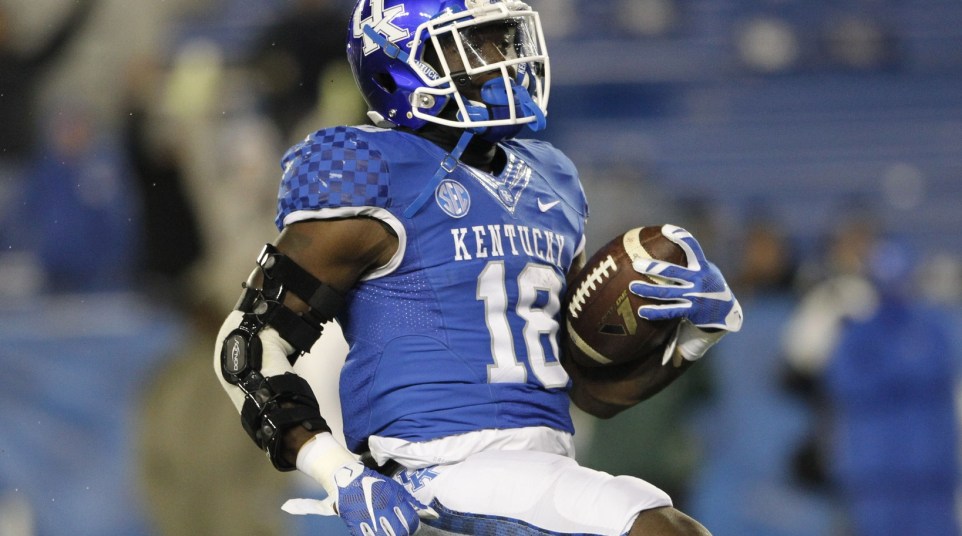
Predicting the SEC's 1,000-yard rushers in 2016
Reaching 1,000 rushing yards no longer is an anomaly within the SEC. In fact, the last three seasons, it’s happened a total of 24 times in the conference.
Still, it’s a significant milestone. A nice, round number. Every now and then, a Kelvin Taylor (1,035 yards in 2015) will reach that mark without being particularly impressive. Or a T.J. Yeldon (979 yards in 2014) will fall just short.
Most of the time, it’s a barometer that separates the great from the good to mediocre. It’s also a status symbol for teams that find their identities within a punishing running game.
We’ve still got 12 SEC spring games to go, and there’s time for injuries and newcomers to change the landscape in the fall. But as spring practice starts nearing conclusion, here are the ball-carriers we expect to reach 1,000 yards in 2016.
THE REPEATS
Leonard Fournette, LSU: The Tigers star may not even need a half-season to reach the 1,000-yard mark, as he surpassed that number in the first five games of last season. If he stays healthy and LSU makes the College Football Playoff, a 2,000-yard season and a Heisman Trophy should be well within his grasp. Of course, the one thing Fournette hasn’t proven is that he can slice through Alabama’s terrific defensive front seven.
Jalen Hurd, Tennessee: At 6-foot-4 and 240 pounds, Hurd will punish you if you don’t have some forward momentum at the point of contact. One of the SEC’s best workhorse backs as a sophomore in 2015, he’s got a chance to emerge nationally within the upper tier at the position. It doesn’t hurt that he’s flanked by quarterback Joshua Dobbs and fellow ball-carrier Alvin Kamara, which keeps defenses guessing even on obvious running plays.
Ralph Webb, Vanderbilt: Listed at 5-foot-10 and a doughnut more than 200 pounds, Webb has got to be one tough son of a gun. He managed more than 1,300 yards of total offense in ’15 behind a weak offensive line and alongside a historically bad passing game. Often one of, or the, only player that defenses had to make sure to contain, Webb still managed seven games of at least 90 rushing yards. With the ‘Dores expecting a modicum of offensive progress in ’16, one would surmise Webb has an excellent chance to repeat the 1,000-yard milestone.
GOOD PRODUCTION GETS BETTER
Nick Chubb, Georgia: The 2016 season may be the one chance we have to see a full-fledged college season from Chubb. He spent the first part of ’14 stuck behind Todd Gurley, though he still rushed for 1,547 yards. Then Chubb suffered a season-ending knee injury in ’15. Sony Michel rushed for 1,000 yards as a result, though Chubb managed 747 rushing yards on just 92 carries. If he gets even 10 games as the feature back, expect the 1,000-yard mark to be a mere formality.
Stanley “Boom” Williams, Kentucky: A rudimentary check of Williams’ rushing totals as a freshman (486 yards) and sophomore (855 yards) paints an upward trajectory that makes him a good candidate. Yes, there’s something to the thought that Williams — listed at 5-foot-9 and 196 pounds — is not a 30-carries-per-game player. He’s faced some disciplinary issues and dealt with an elbow injury in ’15. But with a career average of 6.9 yards per carry, it seems almost unfathomable that his career single-game high is 18 carries. We expect new coordinator Eddie Gran to give him the ball at least enough times for him to reach the four-digit threshold this fall.
Jovon Robinson, Auburn: A faction of the media and fans believed that Robinson would become the alpha ball-carrier straight away in 2015. But it took the JUCO transfer time to adjust, and the Tigers coaching staff time to trust him. Still, Robinson’s 619 yards in the season’s final six games offered a long look at his All-SEC potential. Now that Peyton Barber left early for the NFL, we’d expect that late-season production to continue in 2016.
(RELATIVELY) NEW TO THE SCENE
Devwah Whaley, Arkansas: It’s bold to project Whaley will rush for 1,000 yards as a true freshman. He has yet to carry in a college game, and may not enter the season as the starter. Still, there’s plenty of opportunity for more than one Razorbacks running back to get carries. Even if Rawleigh Williams III and Kody Walker get their share of touches, Whaley is the most gifted of the three. We project him to emerge as the first option at some point in the season. Arkansas has produced four 1,000-yard rushers in the last three years, so there’s a road map for that sort of production. Alex Collins managed 1,026 yards in his first season in ’13.
Bo Scarbrough, Alabama: We’re not willing to say that Scarbrough is going to be the next Derrick Henry. At least not until 2017. But Henry himself managed 990 rushing yards in his second season. B.J. Emmons may be a factor in the fall, but for now Scarbrough and Damien Harris are competing for carries on relatively even terms. It’s early and there’s not a ton of evidence to work from, but we think the 6-foot-2, 230-pound Scarbrough fits the physical profile of a starting Alabama running back. The Tide have produced a 975-yard rusher in each of the last five seasons, so the system should be conducive for Scarbrough to make a push toward that figure if he becomes the first option.
Also considered: Sony Michel, Georgia; Mark Thompson, Florida; Joshua Dobbs, Tennessee
